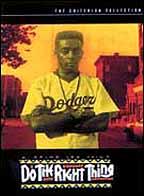FILM NOTES
FILM NOTES INDEX
NYS WRITERS INSTITUTE
HOME PAGE

(United States, 1989, 120 minutes, color, 16mm)
Directed by Spike Lee
Starring:
Danny Aiello . . . . . . . . . . Sal
Ossie Davis . . . . . . . . . . Da Mayor
Ruby Dee . . . . . . . . . . Mother Sister
Richard Edson . . . . . . . . . . Vito
The
following film notes were prepared for the New York State Writers
Institute by Kevin Jack Hagopian, Senior Lecturer in Media Studies
at Pennsylvania State University:
For many years after its founding, the NAACP flew a black flag from the window of its headquarters to honor victims of racial terrorism. In stark letters, the flag said, "A Man Was Lynched Yesterday." Sometimes, the flag was flown for days on end, as tales of racial terror in Florida and Tennessee, Indiana and Georgia, filtered back to the New York headquarters of the organization. The names of most of those victims, beaten, hanged, burned, are lost to all but researchers in dusty archives now. Names like James Clark, killed in July, 1926, in Eau Gallie, Florida, or George Meadows, dead in January, 1889 at Pratt Mines, Alabama or John Richards, killed near Goldsboro, North Carolina, in January, 1916. Or thousands of others between the Civil War and the present. All gone, most forgotten by all but their families.
But there were a few others, whose deaths shone a media spotlight on America's great agony of violent racism. James Byrd, in Jasper Texas, and 14 year-old Emmet Till in Money, Mississippi. There Yusef Hawkins, a 16 year-old Black youth, was murdered by white youths in Bensonhurst, Brooklyn, in 1989. Michael Griffith, 22, had died in Howard Beach, Queens, in 1986, chased onto a highway by whites. Their killings were lead stories, front page above the fold, but director Spike Lee was determined that their deaths would make a new kind of news: the most ambitious American fiction film on Civil Rights since D. W. Griffith's notorious The Birth of a Nation.
What Lee had planned was not the sweeping pseudo-history of Griffith's racist epic, however. Lee's film was to be a horrific miniature of the noisy American conversation about race. A single block, in a single New York neighborhood, on a broiling summer day, is the allegorical setting for Do The Right Thing. Radios blare out into the sun-blasted street, as Mr. Senor Love Daddy, the local DJ and troubadour, tells the `hood its own beautiful, dangerous story, signifying on young and old in rhyming diction. There is the block's old couple, the eternally squabbling Da Mayor and Mother Sister. There is big, silent Radio Raheem, and his thundering boom box, with its dozens of batteries. There is Buggin' Oit permanently on edge, quick to take offense at everything from a racial slur to a scuff on his Jordans. There are the two suspicious heirs to the block's pizza joint, Vito and Pino. Officer Ponte and Officer Long cruise the block, as silent as Raheem, waiting for the neighborhood to kindle and then detonate in the hot summer sun. And finally, there is Mookie, the pizza delivery guy, the block's small black sparkplug, and his pugnacious white boss, Sal, of Sal's Famous Pizzeria. Thundering in the background is Public Enemy's chant of the oppressed, "Fight the Power." But who will fight who? Who has the power here?
Instantly, Do The Right Thing was a cause celebre, more breathlessly (and fearfully) awaited than any American film of its time. Director Spike Lee appeared on the cover of Newsweek, and Oprah and Nightline each devoted an entire show to the film. Behind all the stories was the concern that the film would ignite the very kind of violence it was made to deplore. As Ed Guerrero has noted, this fear has straight-jacketed films of social criticism since the turn of the last century. For Guerrero, this concern is hypocritical, stemming from guilt, deeply ingrown even among the most sympathetic critics. As word of the production made its way around the studios, pressure grew on Lee to mute the film's hardnosed attitudes. Especially, Lee had been warned to ease up on the film's stunning, explosive ending. Production financing proved hard to get when Lee stuck to his screenplay. But he did, and the critics, not surprisingly, were wrong. Fights did not break out in theaters, perhaps because people were too busy thinking.
They are thinking still. More than 15 years after its original release, Spike Lee's film remains a passionate cinematic memorial to Griffith, Hawkins, and the many thousands gone. Do The Right Thing stands with Salt of the Earth, Our Daily Bread, and Fury as a wrenching film of social justice.
The film separates Spike Lee's apprenticeship - the brilliant but erratic She's Gotta Have It and the underrated School Daze - from an artistic adulthood of sustained high ambitions and complex aesthetic values. He Got Game, Malcolm X, Jungle Fever, The 25th Hour, Summer of Sam, Bamboozled,and Get on The Bus are only some of the films which have followed Do The Right Thing, and all have added more chapters to the story of beleaguered race and working-class white ethnicity that Spike Lee announced with Do The Right Thing. And the dead young men of Bensonhurst and Howard Beach speak to us every time Do The Right Thing is screened.
— Kevin Hagopian, Penn State University
For additional information, contact the Writers Institute at 518-442-5620 or online at https://www.albany.edu/writers-inst.
